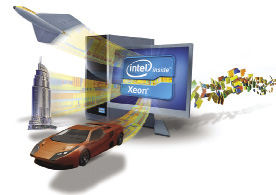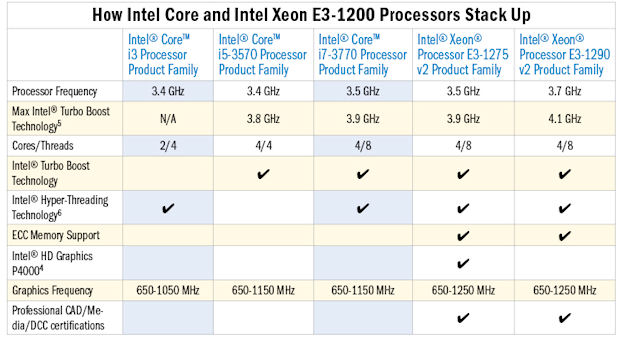Professional Design Demands A Professional Workstation
Latest News
September 1, 2014
 A BMW may be a top-of-the-line ride for most, but its sleek design and superior handling are table stakes for the professional race car driver, who requires a whole other level of performance to get the job done.
A BMW may be a top-of-the-line ride for most, but its sleek design and superior handling are table stakes for the professional race car driver, who requires a whole other level of performance to get the job done.
It’s the same story with engineering workstations. While processor improvements and inexpensive memory have given rise to a new category of low-cost workstations, not every model is created equal when it comes to serving professional engineers. Beyond the need for speed, professionals tasked with designing and building products require a workstation platform that is workload-optimized and specifically calibrated for high-level processing, robust graphics, and precision accuracy. While squeezing faster performance out of a CAD tool can improve an engineer’s productivity, the real gains in innovation and accelerated time-to-market cycles come with new workflows that foster simulation-led design.
Just like a race car depends on components other than the engine to rev up performance, a professional workstation requires more than a state-of-the art processor to drive such advanced design workflows. Along with a processor that supports accelerated I/O performance for large data models, optimized cache utilization, and a data flow architecture for enhanced throughput, a properly balanced system should also draw from ample memory (nearly 2X the size of the largest model), solid state drives (SSDs), and robust-enough graphics capabilities to ensure the optimal productivity boosts from the new workflows.
Simulation-Based Design = Big Results
With this proper mix of components, a professional-grade workstation can be the springboard for an engineer to move past efficient 3D modeling work to simulation-led design and photorealistic imaging. By leveraging simulation studies throughout the development cycle, engineers are empowered to engage in the experimentation that promotes innovation as compared to late-stage simulation, which is keyed to final design validation and the need to reduce costs.
Those steering a course to simulation-led design are enjoying significant results. According to a study by Aberdeen Research, the top 20% best–in-class companies pursuing a robust design approach that includes widespread use of simulation are more likely to meet product launch dates, reduce development cycles, and hit product revenue, cost and quality targets.
Dyson, a respected innovator in consumer goods, is a case in point. By adopting a simulation-led design approach, Dyson engineers investigated 200 iterations of a fan design before settling on a final version, which is 10 times the number possible with physical prototyping. As a result of the new simulation workflows, Dyson engineers honed in on an optimal design, which ensured the fan performed 2.5 times as well as the original concept.
Litens Automotive Group, a tier one automotive supplier manufacturing power transmission systems and components, is another prime example. The company harnessed professional-grade workstations to facilitate simulation-based design—a move that helped it reduce prototyping iterations, save millions of dollars, and accelerate product development cycles.
Both examples underscore a clear ROI for a professional-grade workstation. With the average professional workstation priced around $3,000, the investment amortized over a three-year period translates into approximately $20 a week to realize as much as a 3X increase in engineering productivity.
 Such numbers build a pretty compelling business case for a professional-grade workstation. With a minimal investment, engineering teams can shift simulation-based design into high gear, outpacing their competition and crossing the finish line to enhanced productivity and innovation.
Such numbers build a pretty compelling business case for a professional-grade workstation. With a minimal investment, engineering teams can shift simulation-based design into high gear, outpacing their competition and crossing the finish line to enhanced productivity and innovation.
Configure your ideal workstation.
Professional Workstation Building Blocks
To ensure the best possible workstation experience, aim for balance between four components:
- Processors: Choose the fastest processor possible.
- Memory: Configure system memory to be equal to or slightly more than two times the size of your largest CAD model.
- Storage: Whenever possible, Solid State Drives (SSD) should be part of the specification to ensure maximum impact.
- Graphics: Don’t assume an advanced graphics card is a universal requirement—only invest in what is needed for your applications and workload.
Making the Case
 Need to convince management that a professional-grade workstation is worth the investment? These five questions can help build support.
Need to convince management that a professional-grade workstation is worth the investment? These five questions can help build support.
- What new projects could the company take on if engineers were 20%, 40%, 60%, or even 80% more productive?
- Would you invest in technology that could pay for itself in six months?
- Is it better to increase output by hiring more engineers or increasing the productivity of engineers already on staff?
- What opportunities have we missed by not being able to react quickly to market changes?
- What is the value of avoiding recalls and engineering change orders by having time to get the design right the first time?
Subscribe to our FREE magazine, FREE email newsletters or both!
Latest News
About the Author
DE’s editors contribute news and new product announcements to Digital Engineering.
Press releases may be sent to them via [email protected].







